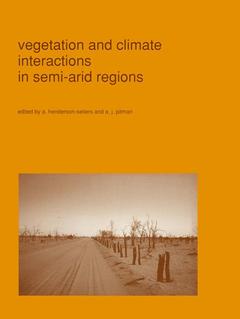Description
Vegetation and climate interactions in semi-arid regions, Softcover reprint of the original 1st ed. 1991
Advances in Vegetation Science Series, Vol. 12
Coordinators: Henderson-Sellers A., Pitman A.J
Language: English
Subject for Vegetation and climate interactions in semi-arid regions:
Keywords
Greenhouse gas; Scale; Southern Oscillation; Vegetation; biosphere; environment; moisture; satellite
Publication date: 09-2012
238 p. · 21x28 cm · Paperback
238 p. · 21x28 cm · Paperback
Description
/li>Contents
/li>Comment
/li>
The chapters in this section place the problems of vegetation and climate interactions in semi-arid regions into the context which recur throughout the book. First, Verstraete and Schwartz review desertification as a process of global change evaluating both the human and climatic factors. The theme of human impact and land management is discussed further by Roberts whose review focuses on semi-arid land-use planning. In the third and final chapter in this section we return to the meteorological theme. Nicholls reviews the effects of El Nino/Southern Oscillation on Australian vegetation stressing, in particular, the interaction between plants and their climatic environment. Vegetatio 91: 3-13, 1991. 3 A. Henderson-Sellers and A. J. Pitman (eds). Vegetation and climate interactions in semi-arid regions. © 1991 Kluwer Academic Publishers. Desertification and global change 2 M. M. Verstraete! & S. A. Schwartz ! Institute for Remote Sensing Applications, CEC Joint Research Centre, Ispra Establishment, TP 440, 1-21020 Ispra (Varese), Italy; 2 Department of Atmospheric, Oceanic and Space Sciences, The University of Michigan, Ann Arbor, MI48109-2143, USA Accepted 24. 8. 1990 Abstract Arid and semiarid regions cover one third of the continental areas on Earth. These regions are very sensitive to a variety of physical, chemical and biological degradation processes collectively called desertification.
Overview.- Desertification and global change.- The role of land use planning in semi-arid areas.- The El Niño / Southern Oscillation and Australian vegetation.- Measurement.- Extrapolation of ‘point’ measurements of evaporation: some issues of scale.- Towards a better model of the effect of prostrate vegetation cover on wind erosion.- The potential contribution of satellite remote sensing to the understanding of arid lands processes.- Sources and sinks of greenhouse gases in the soil-plant environment.- Modelling.- The simulation and prediction of drought.- Vegetation-atmosphere interaction in homogeneous and heterogeneous terrain: some implications of mixed-layer dynamics.- Sensitivity of the land surface to sub-grid scale processes. Implications for climate simulations.- Predicting evaporation at the catchment scale using a coupled canopy and mixed layer model.- Developing an interactive biosphere for global climate models.- Management.- Historical perspectives on some vegetation and soil changes in semi-arid New South Wales.- Available soil moisture as a basis for land capability assessment in semi-arid regions.- Land management in semi-arid environments of New South Wales.- Vegetation changes in the Pilliga forests: a preliminary evaluation of the evidence.- Managing the droughts? Perception of resource management in the face of the drought hazard in Australia.
'I can certainly recommend this collection. The undergraduate student should certainly find this a very useful reference text but the general reader will find much to interest and inform.'International Journal of Climatology, 12' This book is an impressive and truly interdisciplinary collection of outstading scientific contributions on various aspects of semi-arid lands. Even though this book is strongly focused on the semi-arid lands of Australia, agronomists, ecologists, and climatologists from all over the world will find it of great interest. They will not be disappointed. 'Acta Oecologica, 14:1
© 2024 LAVOISIER S.A.S.




